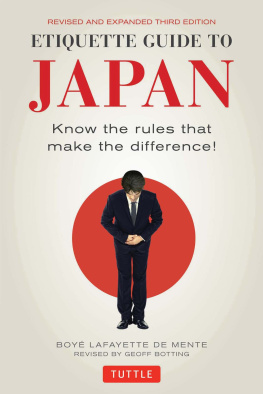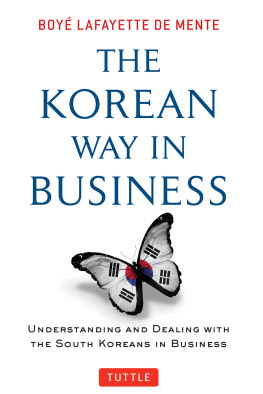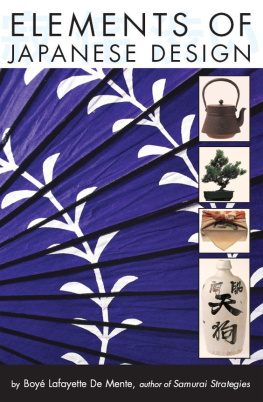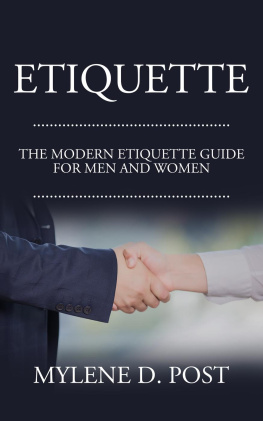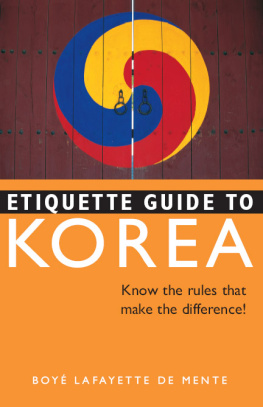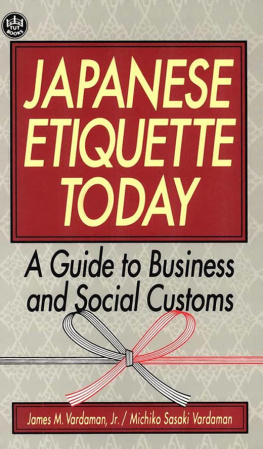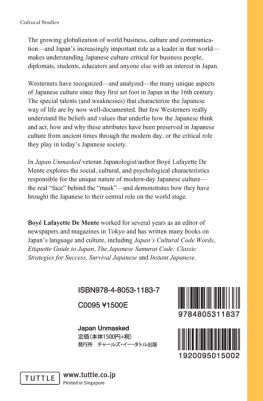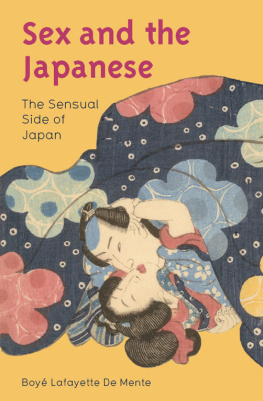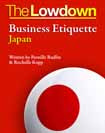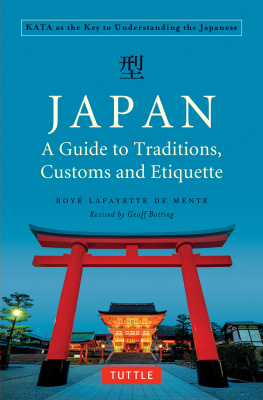Origins of Japanese Etiquette
T he impetus for the development of Japans etiquette-oriented culture no doubt came from the native religion Shinto, which translates as Way of the Gods and is based on maintaining harmonious relationships between mankind, nature, and the cosmos.
Shinto is essentially a type of nature worship in which all things, including rivers, rocks, and trees, are considered to have spirits to whom a degree of reverence is duephilosophical and spiritual beliefs shared by the Hopi, Navajo, and other native American tribes.
The primary focus of Japanese worship was the pantheon of Shinto gods believed to control all the forces of nature as well as the welfare of the people, including the success of crops and human fertility.
Believing that their world was inhabited by innumerable spirits and gods, the Japanese developed a respectful attitude toward the seen as well as the unseen. This attitude was to shape their character from the beginning of their history and set the stage for the emergence of one of the worlds most mannered societies.
According to the creation myth of Japan, Izanagi (Ee-zahnah-ghee) and Izanami (Ee-zah-nah-me), a god and goddess, gave birth to the Japanese islands. They were so enchanted with the beauty of their handiwork that they descended from the heavens to live on the islands. The story goes on to say that the Japanese themselves were the descendants of lesser gods who also settled on the island chain.
The lineage of Japans earliest leaders, who combined the functions of high priest and sovereign, was traced directly to the divine ancestors in whose name they ruled. Thus, from the dawn of its history, Japanese society was structured according to religious tenets that required a very circumspect behavior and numerous formal ceremonies.
Another factor that was to play a crucial role in the development of etiquette in Japan was the sweeping importation beginning in the mid-sixth century of Korean and Chinese fashions, philosophies, and social customs.
Japan borrowed extensively from China in particular. By that time, China was already over three thousand years old and had a highly refined and stylized culture based on a concept familiar to the Japanesea godlike emperor ruling over vassals and slaves and supported by a hierarchy of powerful underlings whose stations also entitled them to reverential treatment.
Chinas contributions to Japanese civilization included its writing system, styles and techniques of art and architecture, technology, medicine, and religious, philosophical, and legal systems. The heart of the Chinese system of etiquette was the culture of the Imperial Court in the Chinese capital, and this became the model for the Japanese.
The Role of Harmony
A ccording to legend, Japans first imperial government dated from around 600 BC . It was based on the concept of k chi kmin (kohh-chee kohh-meen), in which all of the people literally belonged to the emperor, had no inherent freedoms, and could not own private property. This system lasted until the eighth century AD .
The foundation of the social system during this period was harmony, or wa (wah) in Japanese. This was a hierarchical harmony that required each individual, regardless of his or her place in the vertical structure, to do exactly what was expected in the exact manner prescribed. The absolutes in system were peace and a minutely detailed respectall within the context of the superior-inferior structure of the society.
The cultural glue that was designed to uphold Japanese-style harmony eventually came to be subsumed in the word amae (ah-my), which I define as indulgent love. In this framework, all relationships should be based on a kind of love that indulges peoples needs as well as their idiosyncrasies, even when it is disadvantageous to do so. The amae factor in Japanese relationships was rooted in the desire to avoid disharmony and became a key element in the etiquette of the Japanese, protecting and sustaining their kao (kah-oh) or facetheir sense of honor and their reputationby making it possible for them to maintain wa .
The concern with face in Japanese society gave rise to another important element in Japans system of etiquette enryo (inn-rio), which literally means considering from a distance but in practical usage means holding back, not being aggressive. The avoidance of confrontation and aggression is still very much in evidence today, especially during business meetings, lectures, and other situations where most Americans or Europeans would feel free to speak up with questions or criticisms.
In the system of etiquette that evolved around these cultural imperatives, wa was of ultimate importance. All behavior and all relationshipspersonal, public, and professionalwere controlled by a carefully prescribed etiquette that was designed to maintain harmony and often took precedence over both human feelings and practical reasoning.
To hear many older Japanese tell it, wa remains the basic building block of Japanese society and has been responsible for much of its economic success. Many Japanese cultural traits, including decision-making by consensus, groupism, shared responsibility, and even ongoing resistance and criticism of the inroads being made by foreign cultures, are predicated on the need and desire for purely Japanese-style harmony.
Having been conditioned over the centuries to a codified system of behavior that took on the color and force of a religion, the Japanese became so accustomed to a specific Japanese way of doing things that they developed an extreme sensitivity to any deviation from the norm. Unexpected or nonstandard behavior not only disrupted the cultural imperative of harmony, it was extremely stressful and could be dangerous to the individuals concerned.
Japanese today are still extraordinarily sensitive to non-Japanese behavior. This sensitivity and ensuing stress were partially responsible for the general resistance to foreign companies and foreign workers coming into the country that existed until recent times, and also affected Japanese travel abroad. During the 1950s and 1960s some Japanese who traveled for business were so unprepared to handle the kind of casual, chaotic behavior that Westerners took for granted that they became nervous wrecks after only a short period of time. Many of them holed up in their hotel rooms for several days and then returned home. (Also key was that their hosts often insisted on serving them frequent and large helpings of meat, to which they were not accustomed and which typically made them ill.)
Another important aspect of harmonized behavior in Japan was that it made life predictable. Japanese people could anticipate one anothers attitudes and reactions to the point that verbal communication was often unnecessary. The Japanese eventually came to pride themselves on this telepathic ability, pointing to it as one of the cultural characteristics that made them different from other peopleand made their culture superior in many respects.
Since Japans cultural telepathy is generally etiquette-based, it is incomprehensible or even unrecognizable to anyone not intimately familiar with Japanese behavior. Anyonevisitor or resident businesspersonwho wants to truly understand and communicate with the Japanese must learn to appreciate many aspects of their etiquette.
The Vertical Society
E arly Japanese society was divided into distinct classes that were arranged in descending order of power and privilege. At the top of the pyramid was, of course, the emperor, followed by members of the royal family, court officials, Shinto priests and Buddhist monks, members of the military, scholars, artisans, farmers, and merchants.
The social system was a vertically arranged hierarchy of superiors and inferiors in which very specific kinds of behavior were required to demonstrate and maintain social differences and to cater to the vanity of those on higher levels of the pyramid. The common people had few rights and were subject to the wishes and whims of the ruling classes.

